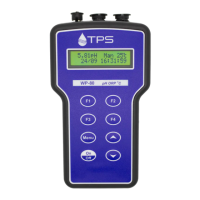4.2 Calibration Notes
1. A 1-point calibration should be performed at least weekly. In
applications where the electrode junction can become blocked, such
as dairy products, mining slurries etc, a 1-point calibration may have to
be done daily.
2. A full 2-point calibration should be performed at least monthly. Of
course, more frequent calibration will result in greater confidence in
results.
3. All calibration information is retained in memory when the WP-80 is
switched off, even when the battery is removed. This information can
be recalled or printed later using the GLP function (see section 8).
4. The WP-80 displays the value of the pH buffer to which it will attempt
to calibrate. Ensure that the buffer value displayed corresponds to the
buffer that you are using.
4.3 Calibration Messages
1. If a 1-point calibration has been successfully performed, the WP-80 will
display the following message, and the asymmetry of the electrode.
For example…
1 Point Cal.OK
Asy= 0.10pH
2. If a 1-point calibration has failed, the WP-80 will display the following
message, and the failed asymmetry value of the electrode. For
example:
1 Point Cal.Fail
Asy= 1.50pH Hi
or :
1 Point Cal.Fail
Asy=-1.50pH Lo
3. If a 2-point calibration has been successfully performed, the WP-80 will
display the following message, and the asymmetry and slope of the
electrode. For example…
2 Point Cal.OK
Asy= 0.10pH
then :
2 Point Cal.OK
Slope=100.0%
4. If a 2-point calibration has failed, the WP-80 will display the following
message, and the failed slope value of the electrode. For example…
2 Point Cal.Fail
Slope=130.0% Hi
or :
2 Point Cal.Fail
Slope= 70.0% Lo

